Combining Academia and Geekdom in D20 Form, a critical look at all sorts of nerdery You can Support me at Patreon, evidently food costs money who knew? https://www.patreon.com/EvilElitest
Don't wanna be here? Send us removal request.
Text
Monster Spotlight: Bagmen

CR 4
Neutral Evil Medium Fey
Adventure Path: Hell’s Vengeance: The Inferno Gate, pg. 84~85
Vile predators that feed upon the unwary and the lonely, Bagmen travel from town to town via lonely roads and dark paths, looking for victims to shove into their namesake bags. Like every murderous Fey that delights in causing misery, Bagmen are cowards above all else, fleeing if a foe turns out to be competent or well-armed and never attacking groups of foes unless their very life depends on it, and of course they much prefer to snatch away children, making them perfect villains for a lower-level party to collapse on.
I’m throwing a lot of vitriol at them, but in truth, Bagmen are quite fascinating in how they operate. They’re capable of using a grotesque method of Fat Extraction on the corpses of intelligent Humanoids, flensing the fat away from the body with their wicked-sharp claws and into a bubbling cauldron. Bagmen use the collected fat to construct Potions of Infernal Healing and Potions of Youthful Appearance which, respectively, grant the drinkers Fast Healing 1 for 1 minute (for a total of 10 HP), and make the drinkers look like beautiful young versions of themselves for 3 hours. While they may be able to make different, more useful potions as needed, Infernal Healing and Youthful Appearance are what allow them to easily integrate themselves into human society, selling ‘cures’ for various injuries and what amounts to incredible makeup for the vain and haughty.
Bagmen aren’t above sampling their own wares, mind, with Infernal Healing especially making them difficult to kill at lower levels when combined with their DR 5/Cold Iron, but they’re compulsively unable to actually hoard the potions, refusing to keep more than four of the things on them at a time… But this just encourages them to sell them to unsuspecting victims, which they take perverse delight in. Any coin they earn is often spent immediately to allow the Fey to indulge in whatever pleasures it can afford, typically via expensive food and drink, making their horrific work worth all the trouble. However, their greatest joy is revealing to repeat customers just what those potions are made of, the disgust at what’s been done often paralyzing the poor soul just long enough for the Bagman to grab hold of them with one of its claw attacks (both of which deal 1d4+4 damage) and then use Bag Prey. A Bagman’s bag can hold 1 Medium or 2 Small creatures at a time, their weight magically negated while they’re in the sack, letting the foul Fey scamper off into the night with their victims in tow without slowing down.
Once secluded from the rest of the population, the Bagmen murder their victims with either their claws or 1d6+6 damage at a time with their handaxe (though the axe has an intimidating x3 critical multiplier) and prepares them to be rendered into gruesome potions. To close off on a disgusting note: Bagmen never eat any fat, regardless of what the rumors may say, but they can consume an entire corpse down to the last bone with unnatural voracity to dispose of even the most horrific crime scene in just a few short hours. Their skill with creating healing draughts and their efficacy when it comes to cleaning up after themselves makes them the perfect partners for cannibal cultists, demon worshipers, and Fey even more vile than they.
You can read more about them here.
41 notes
·
View notes
Text
Brainiac

[As you should expect from me at this point, my entry into the sub-genre of “mind flayer expy” is a little…different. The delightfully weird film that inspired this is in the public domain and available through archive.org So go watch it!]
Brainiac
This grotesque creature appears to be a furred, bat-like caricature of a human figure, with an oversized head and a fanged mouth. A long forked tongue protrudes from its jaws. Rather than hands, the thing bears two-pronged, fleshy pincers, each ending in a sucker-like tip. Despite its hideous form, it dressed in fashionable attire.
Sometimes referred to as “space vampires”, brainiacs are weird undead creatures that use psychic powers and shapeshifting to revenge their own deaths. A brainiac is created when a wronged occult caster culminates a ritual in which they are slain by others, destroying their body in flame and recreating it in monstrous form on a comet. Brainiacs may spend decades or centuries flying through the solar system, plotting an elaborate revenge method to destroy the lineages, countries and legacies of those who scorned them in life. When they do return, they often pose as nobles, eccentric scholars or amateur astronomers, the better to explain their in depth knowledge of past events and occult lore.
A brainiac is usually too clever to get themselves trapped in combat against a prepared foe, but they are extremely arrogant and sensual creatures. Pleasurable senses are dulled in their monstrous bodies, and many brainiacs enjoy committing their crimes and indulging in hedonism while in living form. Rather than eat the brains they extract immediately, many brainiacs choose to elaborately cook and season them before consuming them in mortal guise, increasing the likelihood they are caught in the act.
A brainiac is the size of a human, but their heads are overlarge. In their monstrous form, their deformed craniums tend to pulse and warp when the creature uses its hypnotic stare. Although they can traverse the gulfs of space as they choose without waiting for planetary alignments or the paths of comets, doing so drains them of all of their psychic magic for the day, and even a simple spell will prevent a brainiac from being able to accomplish the journey.
Keep reading
49 notes
·
View notes
Note
What's your options on bugbears in Golorian being all serial killers or atleast obsessed with fear? I think that has room for, improvement. Definitely feels weird for them though.
I love it.
It's one of my favorite lore changes between D&D and Pathfinder. It makes bugbears feel less like "goblin, but giant". And Paizo has made it clear that some goblins mutate and just grow to Medium size, so you can have giant goblins if you want 'em.
@monstersdownthepath suggested that bugbears have a demonic taint to them. Despite their CE nature, I'd suggest sahkils instead. Bugbears are the Fear of Marauders, of Banditry, of Murder. Only they're mortal. But I bet a lot of their souls end up in Xilbaba when they die.
I imagine that small groups of bugbears are somewhere between bandit gangs and terrorist cells, roaming around and striking for maximum psychological impact as much as to get material goods. Larger communities would be like Halloweentown, only much less friendly. With running competitions for "most blood drained in a single evening". And adopting more terrible monsters into their numbers as Honorary Bugbears. Life's no fun without a good scare! If the Thing Hiding Under Your Stairs and The Shadow on the Moon At Night really wanted to kill you, and then looted your supplies and took over your village until the well runs dry or next year's crop doesn't plant itself. That's a bugbear clan.
I also love the implication in Ironfang Invasion, through characters like Scarvinious and Scabvistin (great naming convention too, IMO), that some, but not all, bugbears are envious of hobgoblins. They like the idea of civilization, of order and rigidity. And so they enlist. And because of their strength and power, they can succeed. If they "beat the bear" out, in Scabvistin's words.
So if you want to give bugbears another hook, here's my alternate, but not necessarily incompatible take. They're brood parasites. Because what's scarier than a baby that's not yours taking over your life?
We know that in Pathfinder canon, goblins and hobgoblins are both communal breeders (thanks to nursery locations in both Rise of the Runelords and Jade Regent). A mother bugbear sneaks into a goblin creche and leaves her baby behind, after killing one of the young and either eating it themselves or feeding it to Junior. The somewhat addlepated and mutation-prone goblins won't notice or mind a slightly hairier infant, right? And then the bugbear baby takes more than its fair share of resources, maybe knocks off a few of the other kids, and then either leaves the goblin colony at a young age in order to find more bugbears, or stays and muscles his way into a leadership position.
Doing the same to a hobgoblin community is riskier. The hobgoblins are much more in tune and observant. But in this case, it becomes more of a mutualistic relationship that could tip into parasitism on either end. Maybe the bugbear can get along in the hobgoblin village by learning discipline, or be content with the role of scavenger or brute. Or the bugbear could try to take over, if the hobgoblins are weak. And if the bugbear doesn't have the resources to survive and thrive, the hobgoblins send them off on a suicide mission.
And even though they only rely on other goblinoids for raising their young...most of the time, there are rumors that they do this to other peoples. Even if it happens once in a hundred years, everyone will know the story of how the Munson boy got very hairy and very big very quickly, and then slaughtered and spit-roasted the family dog when he was only 4? That kind of fear keeps the bugbears powerful. And makes the bugbears very happy.
161 notes
·
View notes
Note
I'm only saying this for your sake, but objectively, it's not a smart idea to bring politics into normal hobbies. You might lose supporters of your blog just because of your political stance, and that would be terrible since you're so amazing!! It's only a suggestion, but I really reccomend not bringing politics into anything.

193K notes
·
View notes
Text
Azata, Aeolaeka

Image © Paizo Publishing, accessed at Archives of Nethys here
[Sponsored by @razzelmire, from Pathfinder 2e. I’m glad someone at Paizo is of the same mind as me as far as “rock cycle = naturally chaotic process”. I have a protean of plate tectonics in the works. Because the original flavor text stressed how they make deals with mortals, I wanted to make sure they were at the HD cap for planar ally and planar binding spells.]
Azata, Aeolaeka CR 12 CG Outsider (extraplanar) This beautiful humanoid is seemingly carved from stone and twice the height of a typical human. They have satyr-like features, with curling horns and hoofed legs.
Aeolaekas are sometimes called stone azatas, as they embody the chaos of rock and earth. Any substance that can become dust or diamonds is seen by the azatas as embodying chaotic potential. They are, however, more patient than most other azatas, as such transformations tend to require geological timescales to occur. They are often contacted by mortal summoners for their steady heads and willingness to make lasting pacts. Some of the angelic statues found in city squares or public buildings might even by an aeolaeka waiting patiently for the time when its contract needs to be fulfilled and it must fight to protect the innocent.
An aeolaeka is an implacable foe, batting aside lesser enemies in order to concentrate on the one it considers most dangerous (often the one dealing the most collateral damage). If facing a mass of enemies, they can crush them with an avalanche of magical boulders, but wouldn’t dare use this ability if innocents might be caught in the crossfire. They might make hit and run attacks if in a cave or on solid ground, using earth glide to take enemies unaware, but only if their charges are suitably protected without their direct physical presence. All aeolaekas are willing to fight to the death against the forces of evil if they must.
When not attending to mortal affairs, aeolaekas are often found admiring geological processes. As they are immortal and patient, one might remain in a cave for millennia to watch how stalactites and stalagmites grow and crumble, whereas another might live atop a mountain to monitor its erosion versus uplift. They often take the long term view, which makes them slightly at odds with typical azatas, but they get along well with creatures of elemental earth, even lawful ones such as shaitans. They often fight against evil elemental creatures, particularly salamanders and efreets.
A typical aeolaeka is twelve feet tall.
Keep reading
59 notes
·
View notes
Text
Nyuvwira

Image © @a-book-of-creatures, accessed at A Book of Creatures here
[The nyuvwira is a monster from Malawi, and one that I’ve wanted to do ever since A Book of Creatures first posted about it. But it slipped through the cracks and out of mind until was considering the World Tour theme block. I knew I wanted to cover this once I got to Africa.]
Nyuvwira CR 17 CN Magical Beast This enormous serpent is the size of a building. It has eight heads, all clustered together on short necks, and the air around it crackles with ozone.
A nyuvwira is a serpentine monster that lives deep underground, where it gathers and protects the riches of the earth. They eat both metal and gemstones, which combine in their bodies to form powerful electrical currents that serve the nyuvwira as both offense and defense. They are covetous and selfish, dangerous to miners and travelers underground, but not necessarily evil. They value interesting metals and minerals more than they do flesh, and so may be bribed to pass through their domains safely.
The bite of a nyuvwira is relatively weak for a creature of its size, but the fact that it has eight sets of jaws, each of which carries lethal venom, makes their relatively low physical strength less of a liability. Creatures that try to fight back find their strikes repelled by a field of static electricity, which can be enhanced to a deadly shock in short pulses. This field can be focused further into a terrible weapon, capable of striking with electric death from afar. It cannot use this chain lightning indefinitely, and so may retreat if it manages to use it for the day without a decisive finish to the combat.
Much of a nyuvwira’s treasure is found in its bones, organs and scales, the gemstones and conductive metals incorporated into its body. A nyuvwira is usually found with a standard treasure value for its CR in coins, metal objects and gemstones, with another standard treasure value for its CR in its tissues, salvageable with a successful DC 25 Survival check and 1d4+1 hours of work.
Keep reading
108 notes
·
View notes
Text
Viskithrel
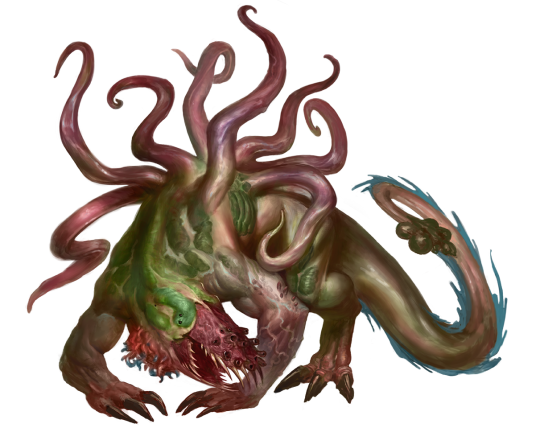
Image © Paizo Publishing, accessed at Archives of Nethys here
[Sponsored by @vonbaghager. Of the various Paizo APs published since the change from 1e to 2e, Extinction Curse is definitely the one I'm most interested in. I might even end up running it, although I would probably back-convert it to 1e. So the excuse to retro-convert its monsters is one I am happy to have.]
Viskithrel CR 15 NE Magical Beast This mammoth-sized creature is a strange parody of a reptile, its entire body covered in natural weapons. Its jaws are long and filled with needle-sharp teeth, its four limbs all end in three clawed digits, its tail is tipped with a bony club and eight tentacles grow from its back. It has a dozen nostrils, irregularly scattered along its snout like the tubes of marine worms, four beady eyes, and a short tentacled beard.
Viskithrels are strange Abyssal predators native to Gluttondark, the layer controlled by Zevgavizeb. Their anatomy combines features of multiple species of lizards, dinosaurs and cephalopods, with extra eyes and extra nostrils thrown in for good measure. Their extra nostrils and strangely chambered sinuses give them one of the best senses of smell known to sages—they can follow a trail by scent that has been cold for weeks, partition a stinking cloud spell into one nostril and out the other unharmed, and pinpoint creatures by their aromas. They are extremely, aggressively social creatures. A lone viskithrel will attempt to find others of its own kind via scent for days.
Viskithrels rarely bother with stealth, using instead their endurance and pack tactics to run down victims and tear them apart. Their tentacles are covered with short sharp thorns, like the rasp of a cat’s tongue, and they leave shallow bleeding wounds. Their saliva is acidic, and their stomach contents even more so, and a viskithrel will happily swallow a smaller enemy whole. Viskithrels have a strange psychological compulsion and will only swallow enemies whole if the viskithrel is fighting in a group. A viskithrel refuses to eat unless it is in proximity to another of its kind, or another creature it recognizes as part of its pack. Viskithrels summoned alone to the Material Plane have been known to go on violent rampages, killing without eating until they drop dead from exhaustion and starvation.
For such aggressively violent monsters, viskithrels are remarkably benevolent to their own kind. They are excellent parents, will adopt unrelated individuals into their packs with little resistance, and avoid other packs or engage in intimidation displays rather than fight each other to the death. A viskithrel can be convinced that other species belong to its pack, although they are not known to accept creatures other than reptilian monsters in such roles. Some powerful troglodytes and other worshipers of Zevgavizeb have been able to convince a viskithrel to accept their organization as a suitable pack, and thus have recruited a deadly ally.
Viskithrel CR 15 XP 51,200 NE Huge magical beast (extraplanar) Init +10; Senses blindsight 100 ft., darkvision 60 ft., Perception +20 Defense AC 30, touch 15, flat-footed 23 (-2 size, +6 Dex, +1 dodge, +15 natural) hp 220 (21d10+105) Fort +16, Ref +18, Will +11 Immune inhaled poison, olfactory attacks, sickened Defensive Abilities evasion, predatory leap Offense Speed 40 ft., swim 20 ft. Melee bite +27 (2d6+8 plus 1d6 acid plus grab), 2 claws +27 (1d10+8), 2 tentacles +25 (1d8+4 plus bleed), tail slap +25 (2d6+4) Space 15 ft.; Reach 15 ft. (20 ft. with tentacles, 10 ft. with claws) Special Attacks bleed (1d8), swallow whole (AC 17, 22 hp, 2d6+12 plus 2d6 acid) Statistics Str 27, Dex 23, Con 18, Int 4, Wis 18, Cha 9 Base Atk +21; CMB +31 (+35 grapple); CMD 48 (52 vs. trip) Feats Bleeding Critical, Combat Reflexes, Critical Focus, Dodge, Improved Critical (bite), Improved Initiative, Multiattack, Nimble Moves, Power Attack, Toughness, Vital Strike Skills Acrobatics +18 (+22 when jumping), Climb +16, Perception +20, Survival +9 (+17 tracking by scent), Swim +20; Racial Modifiers +4 Acrobatics, +8 Perception, +8 Survival (tracking by scent) Languages Abyssal (cannot speak) SQ impossible scent Ecology Environment warm forests and swamps (Abyss) Organization solitary, pair or pack (3-8) Treasure none Special Abilities Impossible Scent (Ex) A viskithrel is immune to any inhaled poison or olfactory attack. It gains blindsight 100 feet through its sense of smell, which can only be disabled by magical means such as curses. A viskithrel gains a +2 to the skill check DC to follow tracks by scent every day, not every hour. Predatory Leap (Ex) As an immediate action when it is about to be struck by a melee attack, a viskithrel can make an Acrobatics check with a DC equal to the attack roll. If it succeeds, it negates the attack. Regardless of whether it succeeds or fails, it can then move up to half its speed without provoking attacks of opportunity. If its movement ends near a creature suffering from a bleed effect, it can make a bite attack against that creature as part of the same action. When a viskithrel uses this ability, it is staggered for its next turn.
83 notes
·
View notes
Text
Timara
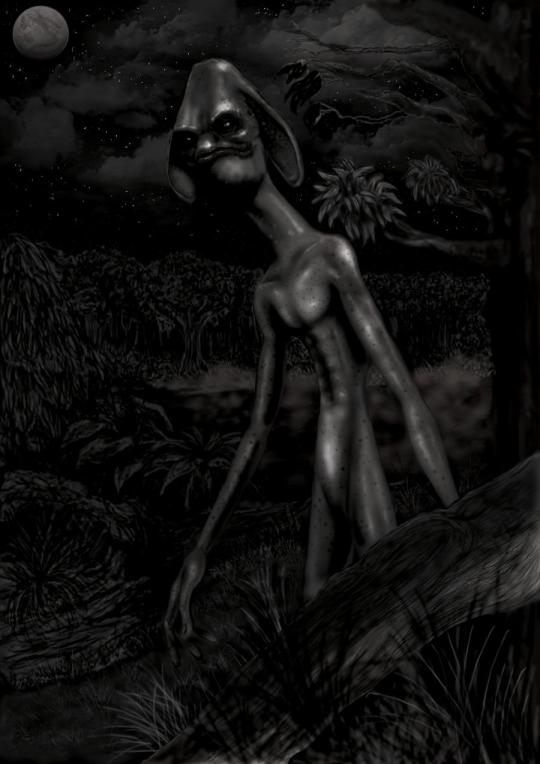
“DreamWalker” © deviantArt user “Kattang”. Accessed at his gallery here
[Commissioned by @wannabedemonlord, of a set with the imjin. The timara has more of an internet presence than the imjin, for a slightly stupid reason. Because it is a tall, thin humanoid, Slenderman stans have claimed that it’s evidence that Slenderman is “real”.]
Timara CR 4 CG Fey This humanoid is twice the height of a man but rail-thin. It has rubbery black skin, oversized ears, and carries a satchel filled with rocks.
The timaras are gentle but mischievous fey giants native to warm forests. They are so skinny that they can hide behind trees and in the cracks in rocks. Oftentimes, they live near dangerous places and use their powers to keep unsuspecting mortals from coming too close. Wicked fey, however, are their enemies, especially the predatory imjins. If imjins are afoot, timaras will use magic to communicate with each other over wide distances and gather to stop their attacks. A timara prefers to keep its distance in combat, pelting opponents from afar with thrown rocks. If forced to close, they use flint-tipped spears or their fists to fight. Timaras can magically manipulate plants, and often use this ability to hinder or attack foes in their natural terrain.
A timara stands between ten and twelve feet tall, but they are so skinny that they weigh no more than an average human.
Keep reading
51 notes
·
View notes
Text
Bodendruker
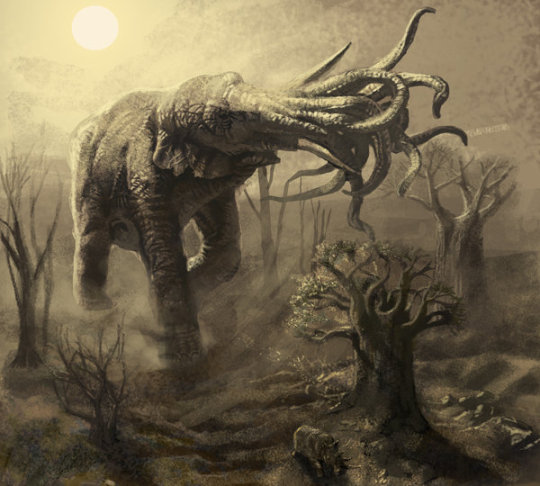
“Cthonian Elephant” © Niel Venter. Accessed at his deviantArt page here
[The second Basic D&D commission from @justicegundam82. This monster seems to be better remembered than the hydrax, as Google Image searches turn up several illustrations, including the not-intended-to-be-one-but-fits-perfectly image above.]
Bodendruker CR 18 N Magical Beast This creature looks something like an elephant, but is more than three times its size. Rather than having a single trunk, its face sprouts eight octopus-like tentacles, which probe the air around it.
The bodendruker is called the “leveler” by many that cross its path, and for good reason. It is capable of destroying any inanimate object that would impede it, tearing down trees and crushing uneven ground to a smooth polish. They live in deserts, although they may not be deserts when the bodendruker enters them—its very passage is wildly destructive to plant life. As such, they tend to be despised by plant-loving druids and those seeking to keep grasslands from being claimed by the desert.
A bodendruker is a carnivore, and its favorite prey is subterranean creatures such as purple worms. Many burrowing beasts are attracted to the vibrations of the bodendruker’s footsteps, whereupon they are seized and crushed by the ravenous monster. A bodendruker can survive for extended periods of time on a single meal, and their metabolisms run slowly. They are diurnal and sleep through the night standing up, trusting to their immense size and toughness to keep from being disturbed. They are solitary creatures, unlike the elephants they superficially resemble, but small bands may congregate to mate or if food sources are especially common.
A bodendruker stands forty feet tall at the shoulder and weighs 20 tons.
Keep reading
266 notes
·
View notes
Text
Wheel of Monsters

Image © @bowelfly
[April Fools! Like previous April Fools' monsters I've done, this is intended to be fully usable at table, just... weird. Most of my previous April Fools monsters have been pop culture references, and this one is, just a little slantwise. The expression "wheel of monsters" has been rattling around my head for years, inspired by game shows and game show parodies like Wheel of the Worst. The monsters its summons pulls from by default are mostly ones on the Codex, but I've included guidelines on how to customize it if you don't want to look up a whole bunch of bespoke stat blocks (assuming, of course, anyone actually uses this abomination at table).]
Wheel of Monsters CR 15 CE Aberration This thing is a quadruped with a long tail and clawed limbs, but its semblance to sane life ends there. Instead of a head, it has a vertically oriented dial with twelve facets, each with a different combination of eyes, teeth and strange glyphs. A single eye sits in the center of the wheel atop the axle. Spikes protrude forward from the edge of the wheel, plucked by a stinger at the end of a long tail. Said tail also has a strange flap on it that has the appearance of a sign, or possibly scoreboard.
The wheel of monsters is a strange tool in the service of the Dominion of the Black. They were invented by the daelkyr Harsanash, whose interests lie in the role that chance events play in increasing entropy and the downfall of complex systems. The wheels of monsters exploit chance by generating random spells and summoning random monsters, drawn from distant worlds under Dominion control or the depths of the Dimension of Dream. These far-flung summons have already had disastrous effects, as now both the quori and beholders know about Golarion and its corner of space, and gaze upon it with envious eyes.
Despite their grotesque appearances, wheels of monsters are quite intelligent—geniuses by the standards of humanoids. They tend to have something of a split personality; obsequious and loyal to higher ranking Dominion creatures, even less powerful ones, but snide and condescending to most other lifeforms. Most wheels of monsters have a fondness for cracking jokes and giving color commentary during combat. All of its many mouths are capable of speech, and it can alter the pattern and coloration on its tail flap with incredible precision in order to spell out words in any language it knows. A common behavior is to speak primarily through one mouth, with an unctuous tone, while making sounds like crowd noises and cheers with its other maws.
A wheel of monsters is usually on the move in combat, stalking from place to place in order to better make use of their spells. They are excellent climbers and have at least the possibility of flight through their random spellcasting, and so prefer to have a birds-eye view of the action in order to better place monsters or effects. A wheel of monsters keeps its tactics flexible, but almost always summons a monstrous minion as soon as it can to engage foes. In melee, they can sting with their plectrum tails, inducing confusion in foes, and grab with their claws. They prefer to split those attacks up, stinging enemies to disrupt their tactics and then focusing the bulk of their violence on a single target. If a wheel of monsters has a foe grabbed, it lowers its spiked face on top of their victim and spin it, tearing with all of its spikes and teeth simultaneously. When fighting on their own terms, wheels of monsters will gladly flee a losing fight, but gladly sacrifice their lives in order to promote the objectives of their superiors.
Appropriately enough for a creature of weaponized chance, different wheels of monsters may be able to call forth different spells or summons by spinning their wheels. In order to adjust the wheel of monsters’ spellcasting spin, replace some or all of the spells with spells of the appropriate level. A wheel of monsters can call upon two spells of each level from 1st to 6th. In order to adjust the wheel of monsters’ summoning spin, replace some or all of the monsters with monsters of the appropriate challenge rating. A wheel of monsters can summon two monsters of each CR between 8 and 13.
Wheel of Monsters CR 15 XP 51,200 CE Large aberration Init +8; Senses darkvision 60 ft., low-light vision, Perception +27
Defense AC 29, touch 17, flat-footed 24 (-1 size, +4 Dex, +1 dodge, +3 luck, +13 natural) hp 225 (18d8+144) Fort +17, Ref +16, Will +16 Immune curses, disease, poison Defensive Abilities fortune’s favor
Offense Speed 40 ft., climb 30 ft. Melee 2 claws +19 (1d8+7 plus grab), sting +19 (2d6+7 plus confusion) Space 10 ft.; Reach 5 ft. (10 ft. with sting) Special Attacks rake (bite, 4d8+7), spellcasting spin, summoning spin
Statistics Str 24, Dex 19, Con 27, Int 20, Wis 14, Cha 21 Base Atk +13; CMB +21 (+25 grapple); CMD 36 (40 vs. trip) Feats Combat Expertise, Combat Reflexes, Dodge, Improved Initiative, Lightning Reflexes, Mobility, Nimble Moves, Spring Attack, Whirlwind Attack Skills Acrobatics +25 (+29 jumping), Bluff +17, Climb +30, Fly +11, Intimidate +20, Knowledge (arcana, planes) +23, Knowledge (dungeoneering) +26, Perception +27, Spellcraft +20, Stealth +18; Racial Modifiers +4 Perception Languages Abyssal, Aklo, Common, Protean, Undercommon, telepathy 100 ft. SQ no breath
Ecology Environment any land or underground Organization solitary Treasure standard
Special Abilities Confusion (Su) A creature stung by a wheel of monsters must succeed a DC 24 Will save or be confused, as per the spell, for 1 minute. If the confused creature gets the “act normally” result two turns in a row, the effect ends early. This is a mind-influencing compulsion effect, and the save DC is Charisma based. Fortune’s Favor (Su) A wheel of monsters has a +3 luck bonus to its AC and to its saving throws. Spellcasting Spin (Su) At will as a standard action, a wheel of monsters can spin its wheel to cast a random spell. These function as the spell cast at CL 15th, except that it does not provoke attacks of opportunity and the save DC for all of these abilities, if applicable, is DC 24. The save DC is Charisma based. The wheel of monsters can choose the target or area of the spell as normal for any legal target after determining the spell cast. Roll a d12 to determine the spell cast each time the wheel of monsters uses this ability 1. magic missile 2. mage armor 3. blur 4. scorching ray 5. fly 6. lightning bolt (Reflex half) 7. enervation 8. fire shield 9. cone of cold (Reflex half) 10. spell resistance 11. disintegrate (Fortitude partial) 12. globe of invulnerability Summoning Spin (Su) As a standard action, a wheel of monsters may spin its wheel to summon a random monster from the following table. Monsters summoned in this fashion appear within 60 feet of the wheel of monsters and remain for 15 minutes or until dismissed. A wheel of monsters can use this ability as many times per day as 3 + its Charisma modifier (8/day for an average specimen), but can have no more than one monster summoned at a time through this method. Roll a d12 to determine the monster summoned each time the wheel of monsters uses this ability: 1. animate dream 2. neh-thalggu 3. aros 4. quori, hashalaq 5. rukanyr 6. yad-pollom 7. p’nahki 8. quori, du’ulora 9. garsonite 10. gogiteth 11. beholder 12. ectodactyl
341 notes
·
View notes
Text
Imjin
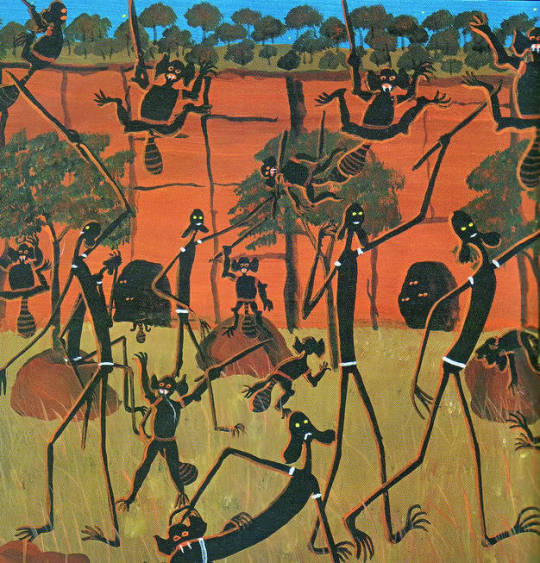
Detail from The Quinkins © Percy Trezise and Dick Roughsey.
[Commissioned by @wannabedemonlord. The word “quinkan” or “quinkin” is used to refer to figures from ancient Australian rock art (current estimates are between 15kya and 40kya). The Ang-Gnarra are the current occupants of the land, and their interpretation divides the figures into benevolent timaras and sinister imjins, among others. These entities are major players in the children’s book The Quinkins, which is my primary source for this adaptation to Pathfinder. That link leads to a read aloud version of the text, with a little animation in the paintings. It’s highly recommended.
Oh, and yes, the “tail” is a bowdlerization. Male imjins are traditionally depicted with giant genitals, and females with pendulous breasts. These are very common folklore motifs. But they’re not something that most folks feel comfortable bringing up at the gaming table.]
Imjin CR 4 CE Fey This ugly little humanoid stands a little shorter than a man, with oversized claws and teeth. It has a pot belly and a fatty striped tail which hangs down to the ground. Its eyes are red and wide, and its ears fan out like an elephant’s.
Imjins are vile fey creatures native to caves. They are hunters of humanoids, but their purpose differs depending on the age of their victim. Adults are killed and consumed, but children are captured and turned into new imjins through sinister rituals. The imjins are enemies of more goodly fey creatures, especially timaras, with which they frequently do battle.
Although an imjin is a fierce melee combatant, they prefer to get enemies off guard through trickery. They are skilled mimics, and may disguise both their voices and their features to lure in potential victims. Imjins rarely engage in ranged combat—if a distance lies between them and their quarry, they close the gap with long hops, bouncing on their striped tails like a kangaroo.
An imjin stands between four and five feet tall. Like many fey creatures, they can live for hundreds of years unless slain in combat.
Keep reading
44 notes
·
View notes
Text
Jackal Lord
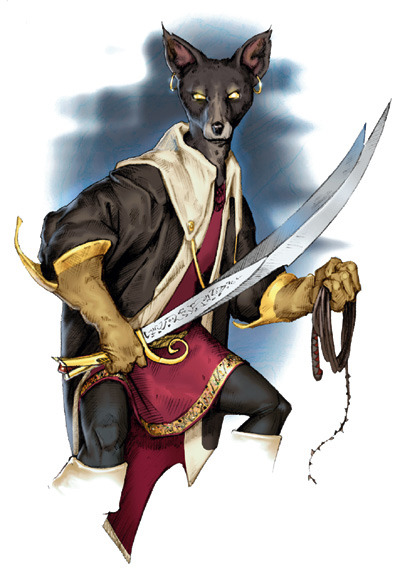
Image © Wizards of the Coast, by Matt Cavotta. Accessed at the Fiend Folio Art Gallery here
[I didn’t know quite what to make of the jackal lord when I first encountered it in the Fiend Folio in my teen years. It seemed redundant to me with the jackalwere (which appears on the very next page), and the idea of racial cleric levels was a little peculiar. Doing research into it for this project, it appears that this, like the seawolf, is a case where a creature deemed to be a lycanthrope in its original form was stripped of that distinction when “lycanthrope” became a template. The jackal lord is based on the Ravenloft werejackal, which are all dedicated to a horror-movie caricature of Anubis. The 3.0 version larded it up with a lot of jackal themed abilities, many (but not all) of which I’ve stripped out of this conversion.]
Jackal Lord CR 8 LE Outsider (native) This humanoid has short, smooth fur and the head of a sinister jackal. It is clad in fine armor and clothing, and carries a well-made blade.
Jackal lords are scavengers of the divine, serving an evil god or archfiend in order to bask in their reflected glory. All jackal lords seek to found and maintain cults to their power of choice. They usually do so through trickery, bribery and intimidation, creating layers of deception to fleece initiates and maintain a psychological grip on established members. Lower level members may not even know the true name of the god they worship. Jackal lords are usually found in humanoid guise, but they transform into their true form if expecting combat, and into full canines to hide or flee.
No two jackal lords have the same tactics, as they all have different magical powers based on the particular god they worship. They prefer to keep a healthy barrier of minions between them and dangerous enemies, summoning oversized jackals if they don’t have a cult to protect them. A jackal lord can transform an enemy into a jackal, and even if the creature resists, it takes on canine thoughts and has a muddled mind for some time. Jackal lords prefer to use this on enemy spellcasters, so that their tactics are disrupted even if they resist the full effects.
Jackal lords are most common in lands where their canine forms can go unnoticed, such as deserts and plains. In realms where evil powers are served openly, they may act as priests and dignitaries, but most prefer the challenge of corrupting beliefs while going unnoticed. Jackal lords toy with their prey, and often have multiple schemes running simultaneously. The targets of these schemes include other jackal lords—they find each other the most odious rivals even if they worship the same god. Jackal lords are sterile and do not reproduce naturally. They are born when a jackal or feral dog feeds from the corpse of an evil cleric at a time of ritual significance—midnight on a new moon, for example.
Jackal lords tend towards lean builds, regardless of their form. Their lifespan is equivalent to that of an elf.
Keep reading
41 notes
·
View notes
Text
Malebranche, Hadriel

Image by Sam Wood, © Green Ronin Publishing
[Commissioned by Soluman Blevins. Hadriel first appeared in the 3.0 book Legions of Hell, as the leader of two whole factions of devils, the Submitted and the Obeyed. This was yet another “BDSM is Evil” themed monster, which were a common theme in RPGs trying to be “edgy” in the 90s and 00s. And her backstory, rebelling against the misogyny of Hell, gives her original flavor text something of a girlboss vibe. I have nothing against either BDSM or rebelling against misogyny, so I wanted to make sure there was something genuinely evil about my take on Hadriel. Long story short, Hadriel is a TERF.
There is a 5e conversion of The Book of Fiends, which has rather more of an art budget and is in full color. I don’t like that rendition of Hadriel as much; she’s more conventionally beautiful and doesn’t even have visible bone hooks. Sam Wood’s more extreme take is very cool and very HR Giger meets Clive Barker. I suspect Hadriel might even have been an influence on Magic: the Gathering’s Elesh Norn, with the sweeping headdress and corset of gore.]
Hadriel Duchess of Domination, Lady Cindara, Mistress Concerns aristocracy, radical feminism, sadomasochism Domains Charm, Evil, Law, Nobility Subdomains Aristocracy, Devil, Lust, Tyranny Worshipers female supremacists, noblewomen, slavers Minions erinyes, handmaiden devils, kytons Unholy Symbol a crossed sickle and riding crop Favored Weapon sickle Obedience spend one hour inflicting pain on a sapient creature without killing it. You may use yourself for this purpose if you do not have a subject on hand. Gain a +4 profane bonus on saves against the staggered and stunned conditions. Boons 1: eagle’s splendor 2/day; 2: charm monster 2/day; 3: waves of ecstasy 2/day (as 6th level spell)
Malebranche, Hadriel CR 21 LE Outsider (extraplanar) This giant humanoid is cruelly thin, with violet skin stretched over bone. Her face is beautiful, but cruel, and a mane of spines grows from the back of her head. Bony hooks protrude from her wrists, and she wears a corset made of bones and a skirt made of tanned leather.
Hadriel, the Duchess of Domination, is a powerful and ambitious devil who became a malebranche on her own initiative. Originally an erinyes, she expected and demanded more power, eventually carving her own body into a stronger and more monstrous form and joining the court of Mephistopheles. In the misogynistic hierarchies of Hell, this entailed acting as a consort to a male pit fiend, who met with a “tragic accident” and had his resources usurped by Hadriel. She has since moved to the Material Plane as her primary base, seeking to sacrifice an entire planet to Hell in order to curry Asmodeus’ favor and gain further advancement. Part of this process has been spurring a cult to form on her behalf, granting her a sliver of divine power.
Hadriel is a sadistic combatant, and although she can end fights in an instant with her mind controlling abilities, prefers to drag them out. She wants to leave enemies broken, beaten and humiliated before making them her slaves. She has two auras, the first inspiring fear and the second an enthralling mental weakness. In melee, she fights with her bone hook and quill-like horns, but rarely fights alone, instead working along with a squad of bodyguards and thralls. She has no compunctions about abandoning a losing battle, leaving her minions behind to die as punishment for their failure.
The Duchess of Domination has shapechanging abilities, and commonly travels the Material Plane under the guise of Lady Cindara, a woman of great wealth and vague royal descent. Lady Cindara is the leader of the Shrieking Violet Society, a women’s club that acts as a front for Hadriel’s cult. Every headquarters is the site of an infernal sigil, part of a plan to transform an entire planet into a magic circle and transport it physically into Hell. Initially, the Shrieking Violet Society seems to be a place for upper class women to converse and advocate for their position, but the more initiated one becomes, the crueler revelations are made. Hadriel’s experiences with misogyny have warped her perspective into a complete reversal, envisaging a perfect society where “proper women” completely dominate men and rule over them with an iron fist. The Shrieking Violet definition of a “proper woman” is narrow, and trans women, gender nonconforming people and others who do not fit their criteria are seen as abominations to be exterminated.
Hadriel stands ten feet tall in her natural form. Her pride prevents her from ever assuming male guise through shapeshifting or illusion magic.
Keep reading
57 notes
·
View notes
Text
Who is the Ghoul?: Hunter the Parenting
So Recently I've really been getting into Hunter the Parenting and I can't get this thought of my head, So this is going to be a blatant indulgence in fandom speculation.

Pictured, Family Game Night
For those that don't know, Hunter the Parenting is a web series set in White Wolf's "World of Darkness" universe, following a family of hunters who are trying to take down a vampire cabal. One of the cast is secretly a ghoul, a blood slave to a vampire, and the last episode ended in a cliff hanger. so I'm going to predict who I think the Ghoul is based on the aviable information. Hopefully the next episode will be out very soon and we can see if I'm right or not.
I predict that the Ghoul is....Grimal.

So I have three arguments for Grimal being the Ghoul, Narrative, Deductive and Meta
First lets talk about the Narrative logic of a betryal story. What makes a Ghoul narrative interesting and compelling is the fact that a close friend can be forced to betray you due to how addictive Vampire blood is. Someobdy you cared about and trusted Turned against you, possibly against their own will. That narrative is only impactful if its a character we and the protagonists like and care about. If the traitor turns out to be Brock, Blacklaw, Git or Spit then the narrative is "person we already don't like turns out to be a vampire spy, fuck them", its not very impactful. If its the doctor or the help its "character we barely know and just met turns out to be the traitor". For the narrative to have a punch, the traitor needs to be somebody who the audience can feel betrayed by, which means we have to actually like them. That leaves Grimal, Harry and Elise, all of whom were set up prior to the last episode. Of the three, Grimal has by far the most characterization, she has the most lines of dialoge, she has the most dynamic personality, and is given the closest relationships to the main cast, as Marcus best friend and Kitten's ex. While Elise is Reserved and Harry is bland, Gimal is is the most exciting and is a major fan favorite, meaning the betrayal would actually be upsetting.

Now on its own, this wouldn't be enough evidence, but lets look at the evidence. Of the suspects, the Ghoul is almost certianly not Blacklaw or Doctor Waters because they already have archive access, which means they would have already stolen the necessary data prior to the groups arrival. The Ghoul is somebody who must be trying to get archive access, which means Security, the Help, or the lesser members. Of whom, Grimal is the only one who has a significent period of time where she is unaccounted for, after Kitten runs off she is (according to the map) in the security room for some reason, and then isn't seen again until after Occams assault.

What is she doing in the security room?
Harry meanwhile is with Marcus the whole time, so he is in the clear, which lease Elise. Who I think is innocent because of when everybody is splititng up (15:55) she voices opposition too it, but quiently enough that only she can hear it. This implies it isn't just something said for show but is guinely felt, and if she was the ghoul, she would be encouraging the discord not trying to hamper it.
There is also the matter of Grimal's body language. At 5:20,5:42, 7:21, 10:22, 10:37, 11:07, 12:24, 13:19, 13:50, and 27:15 Grimal looks super nervous and guilty (espically at 10:22) . This isn't unique to her, but she is the most animated, which I think is a way of subtly hiting as to her guilty nature. Remember animation is hard and time consuming and they are really making sure we see Grimals expressions very distinctly. Not enough to be evidence on its own, but combined with the rest of the evidence I think it is foreshadowing. Grimal also stays super silent whenever characters are discussing who might be a ghoul, which is unusual considering how talkative she is.
Finally from a Meta Perspective, Grimal is the perfect character to be the Ghoul because she doesn't have any ongoing plot threads. Where Harry and Elise are still a bit mystery character wise, but Grimal is probably the most established character outside the protagonists, and thus her being the GHoul is the most upsetting. She also has less use in the future because her major is useless. Harry studies local folklore and Elise studies Fae, both of whom are likely to reappear in the series, buty Grimal studies Kuei-jin, which the series treats as a joke. Grimal is also a fan favorite, making her betrayal the most dramatic of the characters.

So lets talk about some of the other suspects. Spit is the obvious one, as he is acting super sus throughout the entire episode. I think however that Spit is a red Herring, and what ever happened to Lord Fatigue was unrelated to the ghoul. Spit makes reference to his head hurting and some event he didn't want to talk about, I think that he is actually a werewolf and his plotline is entirely unrelated to the situation with the GHoul. Otherwise he is too obviously suspect. Also his issues aren't really Ghoul addiction.
The third suspect I think is Giles, who we know is directly working for a vampire. he lacks the narrative and meta reasons, but if he is the Ghoul, than the ghoul story line is less about a dynamic twist and more about giving the protagonists a way to connect the vampires to the 99 P store.

One last point which I don't think is major evidence but I'll bring it up anyways, Blacklaws stupid Polymath/car battery. According to Brock, the machine shocks you until you tell the truth, and while this is likely just them being idiots, it did seem to work for Grimal when she insulted Brock's face. So its possible that there is something to there stupid machine and it actually does work
57 notes
·
View notes
Text
would this even work in the dagger form?
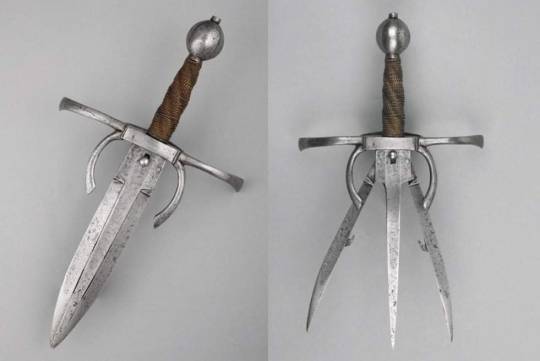
Mechanical Daga (is a fighting knife) , Germany, 17th century.
422 notes
·
View notes
Text
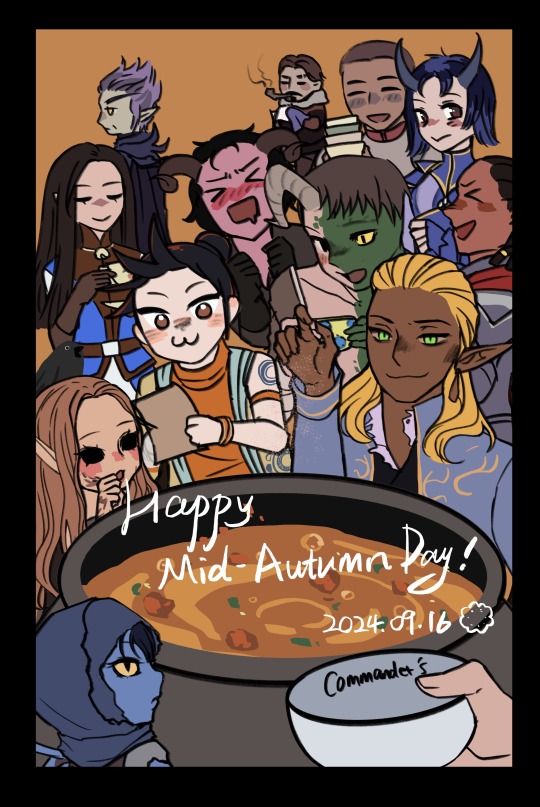
Happy Mid-Autumn Day!
(To the Chinese, Mid-Autumn Festival means family reunion and peace. It's only natural that the Commander spends time with all of his buddies this holiday season!)
中秋快乐!祝各位指挥官盆满饼满事事满!
49 notes
·
View notes
